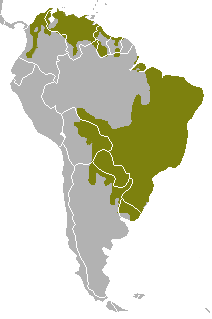게잡이여우
보이기
|
| ||
|---|---|---|
 콜롬비아의 게잡이여우 | ||
| 생물 분류ℹ️ | ||
| 계: | 동물계 | |
| 문: | 척삭동물문 | |
| 강: | 포유강 | |
| 목: | 식육목 | |
| 과: | 개과 | |
| 속: | 게잡이여우속 (Cerdocyon) C. E. H. Smith, 1839 | |
| 종: | 게잡이여우 | |
| 학명 | ||
| Cerdocyon thous | ||
| Linnaeus, 1766 | ||
| 아종 | ||
| ||
| 게잡이여우[1]의 분포 | ||
 게잡이여우의 분포 지역 | ||
| 보전상태 | ||
|
| ||
게잡이여우(Cerdocyon thous)는 남아메리카 중부 지역에서 사는 중간 크기의 현존하는 개과 동물이다. "숲여우" 또는 "나무여우", "커먼여우" 등으로도 불린다. 플리오세 동안에 처음 나타났다.[3] 학명 "케르도키온"(Cerdocyon)은 "여우"(fox)를 의미하는 그리스어 단어 "케르도"(kerdo)와 "개"(dog)를 의미하는 "키온"(cyon)의 합성어에서 유래했으며, 이는 개와 여우를 닮은 이 동물의 특징을 나타낸다.
아종
[편집]5종의 아종이 알려져 있으며,[1] 크기와 털 색깔이 다르다.(Bisbal, 1988).
- C. t. thous - 베네수엘라, 가이아나, 수리남, 프랑스령 기아나, 브라질 북부.
- C. t. azarae - 브라질 북부.
- C. t. entrerianus - 브라질, 볼리비아, 우루과이, 파라과이 그리고 아르헨티나.
- C. t. aquilus - 베네수엘라 북부 및 콜롬비아.
- C. t. germanus - 콜롬비아의 보고타 지역.
계통 분류
[편집]| 개과 |
| |||||||||||||||||||||||||||||||||||||||||||||||||||||||||||||||||||||||||||||||||||||||||||||||||||||||||||||||||||||||||||||||||||||||||||||||||||||||||||||||||||||||||||||||||||||||||||||||||||||||||||||||||||||||||||
각주
[편집]- ↑ 가 나 Wozencraft, W.C. (2005). “Order Carnivora” [식육목]. Wilson, D.E.; Reeder, D.M. Mammal Species of the World: A Taxonomic and Geographic Reference (영어) 3판. 존스 홉킨스 대학교 출판사. 578쪽. ISBN 978-0-8018-8221-0. OCLC 62265494.
- ↑ “Cerdocyon thous”. 《멸종 위기 종의 IUCN 적색 목록. 2008판》 (영어). 국제자연보전연맹(IUCN). 2008. 2009년 3월 22일에 확인함.
- ↑ C. Cartelle and W. C. Hartwig. 1996. A new extinct primate among the Pleistocene megafauna of Bahia, Brazil. Proceedings of the National Academy of Sciences 93:6405-6409
- ↑ Lindblad-Toh, Kerstin; Wade, Claire M; Mikkelsen, Tarjei S.; Karlsson, Elinor K.; Jaffe, David B.; Kamal, Michael; Clamp, Michele; Chang, Jean L.; Kulbokas, Edward J.; Zody, Michael C.; Mauceli, Evan; Xie, Xiaohui; Breen, Matthew; Wayne, Robert K.; Ostrander, Elaine A.; Ponting, Chris P.; Galibert, Francis; Smith, Douglas R.; Dejong, Pieter J.; Kirkness, Ewen; Alvarez, Pablo; Biagi, Tara; Brockman, William; Butler, Jonathan; Chin, Chee-Wye; Cook, April; Cuff, James; Daly, Mark J.; Decaprio, David; 외. (2005). “Genome sequence, comparative analysis and haplotype structure of the domestic dog”. 《Nature》 438 (7069): 803 in 803–19. doi:10.1038/nature04338. PMID 16341006.
- ↑ Nyakatura, K.; 외. (2012). “Updating the evolutionary history of Carnivora (Mammalia): a new species-level supertree complete with divergence time estimates”. 《BMC Biology》 10 (12). doi:10.1186/1741-7007-10-12.
- ↑ Koepfli, Klaus-Peter; Pollinger, John; Godinho, Raquel; Robinson, Jacqueline; Lea, Amanda; Hendricks, Sarah; Schweizer, Rena M.; Thalmann, Olaf; Silva, Pedro; Fan, Zhenxin; Yurchenko, Andrey A.; Dobrynin, Pavel; Makunin, Alexey; Cahill, James A.; Shapiro, Beth; Álvares, Francisco; Brito, José C.; Geffen, Eli; Leonard, Jennifer A.; Helgen, Kristofer M.; Johnson, Warren E.; o'Brien, Stephen J.; Van Valkenburgh, Blaire; Wayne, Robert K. (2015). “Genome-wide Evidence Reveals that African and Eurasian Golden Jackals Are Distinct Species”. 《Current Biology》 25 (16): 2158–65. doi:10.1016/j.cub.2015.06.060. PMID 26234211.
- Nowak, Ronald M. (2005). Walker's Carnivores of the World. Baltimore: Johns Hopkins Press. ISBN 0-8018-8032-7


